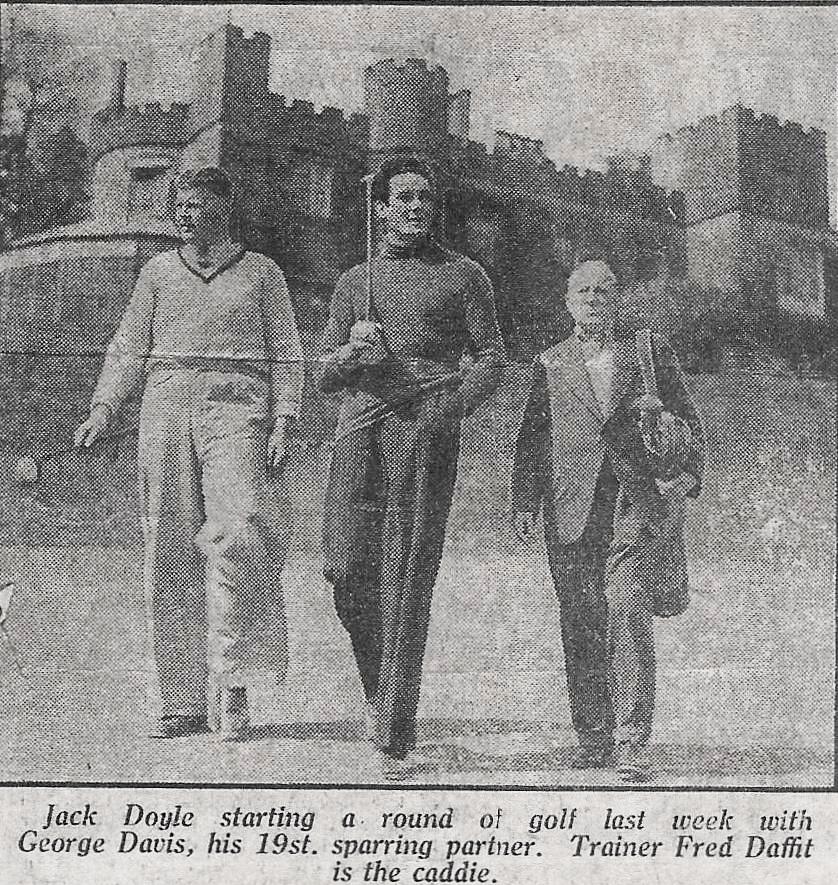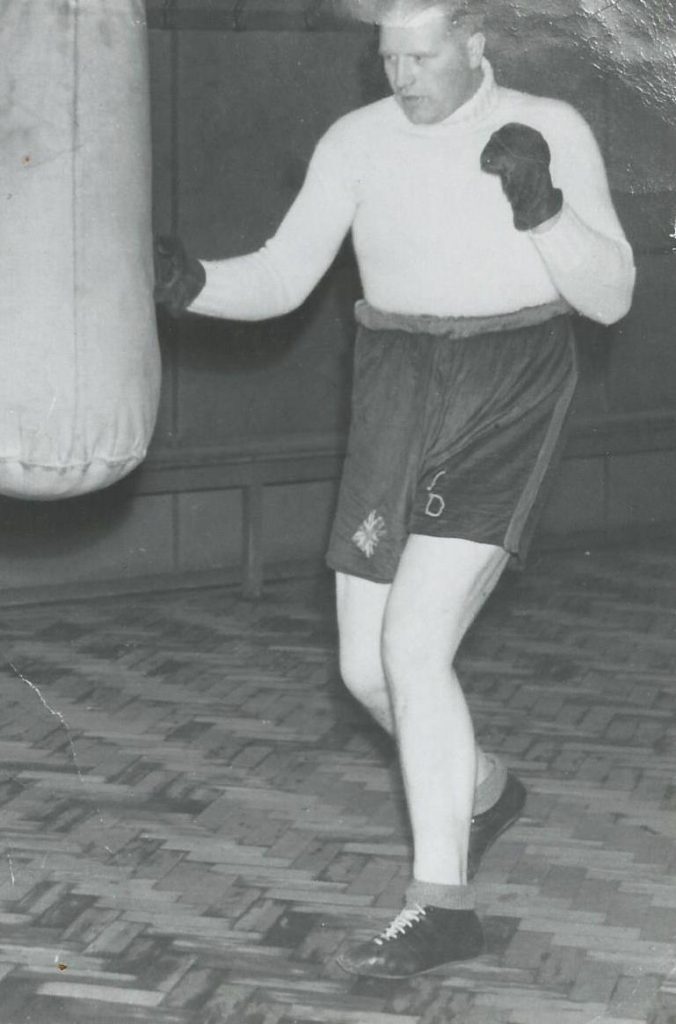George Henry Davis was given various headline titles by the local and national newspapers. These included – The Giant Brickie from Banbury and Britain’s Biggest Boxer. George Henry Davis, along with his brother Norman, was born at Deddington in their grandfather’s pub the Kings Arms. George was born in 1915 and Norman in 1917. They were the sons of George Isaac and Nora Beatrice Davis. At Christmas 1918 their father died in Salonika from Spanish flu as he was about to return from WW1. In 1920 their mother married Ernest Browning and in 1925 the family moved from Duns Tew to the Dog and Partridge in Adderbury where Nora was the licensee from 1925 until 1955. Both of the brothers grew up taking part in local sport and George developed into a very big and strong lad. By 1921 George weighed 19st 4lbs and stood 6ft 6ins in his stockinged feet. He also took a size 17 shoe. There were a number of rumours about his strength including one that said he hit a cricket ball from the cricket pitch in Lucy Plackett playing field over the top of the railway embankment and his strength can be seen in the photo.

On leaving school George joined the local building firm of Bray and Sons as a labourer progressing on to be a bricklayer. What sparked his love for boxing is unknown but he joined the local boxing club in Banbury and fought in the local area as an amateur boxer. I n 1935 with Jack Robeson as his manager. George turned professional and was entered in the Daily Mail £1,000 tournament for novices at Wembley. His manager said ‘this is just what we have been waiting for. We see our big chance in the competition. George is so big and hits so hard I can’t get anyone to meet him.’ He eventually lost to the winner Jack Stanner. The following year George was one of the eight contestants selected for the London and South of England Daily Mail £2,000 Heavy Weight Novices Competition at The Ring in Blackfriars. Because of George’s size and weight he began to make an impression with the various trainers of the top flight boxers He joined the likes of Jack Doyle and Len Harvey’s camps as a sparring partner.

Here he would be paid so much a week, found his board and lodging and paid extra if he could knock the star boxer down. In demand as a sparring partner George began to get his photo in national newspapers alongside the boxing stars. In the picture George on the left is with Jack Doyle at a training camp at Windsor. In one training bout with Doyle, George ‘sustained a bloody nose but couldn’t be knocked off his feet.’ During his career George fought and was a sparring partner or took part in exhibition bouts with a wide range of well known boxers of the time. These included Jack Doyle, Len Harvey, Jack Peterson, Jack London, Bruce Woodcock, Freddie Mills, George Muir, Walter Neuesl, Alf Brown, and Jack Stanner.

George was often compared to Primo Carnera, the World Heavy Weight Champion boxer, in terms of size and weight. In 1937 brother Norman was woken around midnight by George’s trainer throwing gravel at his bedroom window in the Dog and Partridge. There was a message for George saying he was needed down in London first thing in the morning to fight Carnera. Apparently George just said ok and went back to sleep whilst Norman worried all night about the bout. George was needed to spar with Carnera in public and also fight him behind closed doors. Carnera had been refused a boxing licence by the British Boxing Board and needed to prove he was fit to hold a licence. George went to London to the Blackfriars ring but was not needed immediately as Carnera had been arrested and accused of tax evasion. However things were cleared up and the next day George sparred with Carnera in public. The Yorkshire Evening Post reported that Carnera when told he was facing George, remarked ‘the bigger the better.’ George was also reported to have gone 6 rounds with Carnera behind closed doors before being knocked out. Carnera didn’t get a licence.
World War 2 saw George in the Adderbury Home Guard with the rank of lance corporal and this allowed him to continue as a professional boxer. He won his way to the Western Command finals of the new Army Professional Championships which he won not only in 1942 but also 1943/44 and 1945. He also won the North West District Army heavy weight competition. During 1942 he was particularly busy with at least 6 bouts against such opponents as George Muir the New Zealand heavy weight champion. This he lost having beaten Muir earlier in his career. Late in 1942 George was called up to the Royal Army Service Corps as a driver and served his time out in the United Kingdom.

In June 1943 he boxed in a tournament that raised £600 for the Merchant Navy Fund and in August of the same year, as Western Command Champion, he gave a demonstration bout. 1944 saw George defend his Lancs. and Border title and he also boxed Jack London in March 1944 in an interservices competition. In 1945 he knocked out his opponent in the Western Command final in 1 minute and 40 seconds. He was now favourite to win the British Army Heavy Weight Championship. On March 14th at the Blackpool Tower he won the semifinal but on March 24th lost in the final at the Belle Vue arena Manchester. After leaving the army George still had the odd fight. Probably the last one was a ’needle match’ in 1949 against Jim Buster Brown at the Marshes in Southam Road Banbury. A crowd of 1,200 attended the match which ended in a draw. During George’s career before joining the RASC he trained with his good friend Sam Eley. They could be seen running around the village as part of their training schedule and they worked out with a home-made punch bag. Sam related to me how he and George brought back a large sack of sawdust from Banbury builders Hinkins and Frewin. This rested on the handlebars and saddle of George’s bike and when they got it back to Adderbury they filled a canvas punch bag with the sawdust. In 1941 George married Ruby Barrett and they rented the Infant School house. George turned the front room into a small gym complete with punch bag. After the war he returned to the building trade as a foreman and took on the training of some local boys. In the years after the war until his death in 1975 aged 60 he could always be found in Banbury’s Winter Gardens on Boxing or Wrestling night.
Barry Davis
2020
